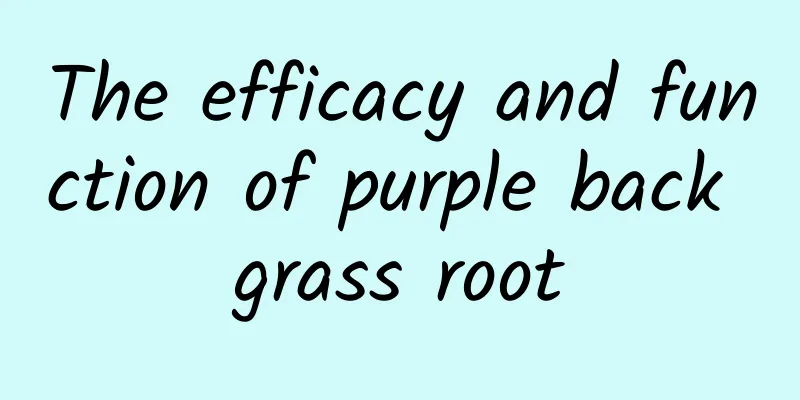The efficacy and function of purple back grass root

|
As a traditional Chinese medicine, purple back grass root has great medicinal value and can treat many diseases. Let’s take a closer look at it below. [Source] Medicinal material source: The root of Senecio purpurogenum of the Asteraceae family. [Original form] Purple-backed Senecio is a perennial herb, 20-70cm tall. There are many fibrous roots, and the rhizome is obliquely ascending with coarse fibrous roots. Stem solitary or in clusters of 2-3, erect, cylindrical, few branches. There are many basal leaves, clustered and flat on the ground, with petioles about 2 cm long; the leaf blades are spoon-shaped, obovate or obovate-lanceolate, 7-12 cm long, 2-5 cm wide, obtuse at the apex, cuneate at the base, extending downward into narrow wings, with irregular coarse teeth or wavy notches on the margins, dark green above, green or purple-red below, hairy when young, falling off or nearly hairless when old, with obvious veins; stem leaves are alternate, with smaller and fewer leaf blades than basal leaves, and almost sessile. Inflorescence, arranged in cymes, terminal; involucre short campanulate, bracts in 1 row, imbricately arranged; bracteoles linear; receptacle flat, with 1 row of ligulate flowers on the periphery, yellow, female, ligules oblanceolate, 3-fissured at apex, tubular at base; pistil 1, ovary inferior, style single, not longer than corolla tube, pappus numerous, as long as corolla; tubular flowers numerous, corolla yellow, 6mm long, tube length 2.5mm, long and narrow funnel-shaped, bisexual, swollen at upper part, 5-fissured at apex; stamens 5, anther fused, filaments divided; pistil 1, ovary inferior, style single, extending beyond the anther, stigma 2-pronged; tubular flowers with numerous pappus on the outside, about half the length of corolla. Achenes are cylindrical, 2mm long, and pubescent; the pappus is pale white and about 5mm long. Flowering period is summer. [Habitat distribution] Ecological environment: Grown on hillsides, in the shade and wet places of grass at the edge of forests. 【Nature and flavor】 Bitter; pungent; cold; slightly toxic 【Functions and indications】 Clears away heat and detoxifies; disperses blood stasis and stops bleeding. Mainly used for stranguria caused by heat; sores; burns; eczema; traumatic injuries; internal and external traumatic bleeding [Usage and Dosage] For oral use: grind into powder, 1-1.5g. For external use: Take appropriate amount, grind into powder and apply on the affected area. 【Excerpt】 Chinese Materia Medica We know the effects and functions of purple back grass root, the edible methods of purple back grass root, etc. I believe the above content can help you! |
<<: The efficacy and function of purple swertia
>>: The efficacy and function of purple whip
Recommend
With thinner legs and more rounded buttocks, why do men have better figures than women?
Have you noticed a seemingly unreasonable phenome...
Mosquitoes: “Little Devil” or “Unsung Hero” in the Ecosystem?
Author: Huang Yanhong Duan Yuechu In our lives, m...
Is the "big crab" in the night sky a trace left by an unusual celestial body thousands of years ago?
Author | Feng Ziyang Review | Dong Chenhui, Zhao ...
The efficacy and function of duck soap bark
Traditional Chinese medicine requires the use of ...
The efficacy and function of palm peel
As a traditional Chinese medicine, palm bark prov...
CIRP: Research shows Amazon's Chinese and American markets are like ice and fire
The Consumer Research Initiative (CIRP), a well-k...
"Lone Moon" is a hit: What kind of comedic sparks can scientists and filmmakers create?
"Hey! Are you all deaf? Can't you hear m...
The efficacy and function of mistletoe
Medicine is a very common thing, but different me...
The efficacy and function of single leaf rock beads
Single Leaf Rock Bead is a common medicinal mater...
The correct way to enjoy the moon during the Mid-Autumn Festival: Check out the Chinese elements on the moon
It’s Mid-Autumn Festival again, a time to appreci...
How did the "Hubei people" manage water resources four or five thousand years ago? The earliest water conservancy facilities in my country have been discovered!
On December 4, archaeological experts from Hubei ...
Do B2B companies need experience management?
With the maturity of the overall economic environ...
The efficacy and function of coix root
As people's research on traditional Chinese m...
The efficacy and function of Amaranthus Root
There are many common Chinese medicinal materials...
The efficacy and function of brome rice
Brome rice is a very common Chinese medicine and ...







![The efficacy and function of longan[picture]](/upload/images/67ca40b363e65.webp)

